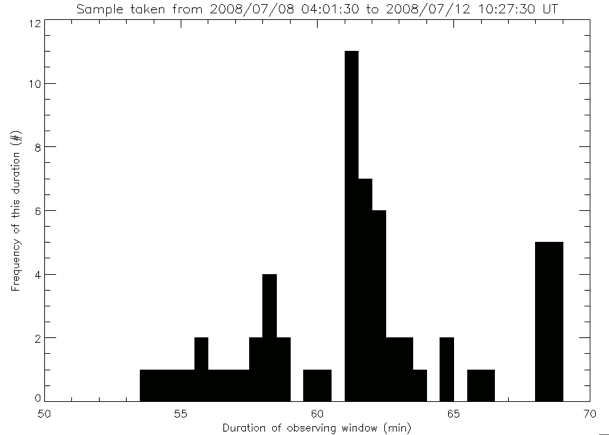Observing with EIS with the new antenna#
About this page#
This Wiki page deals with typical observing constraints that you need to bear in mind when making a proposal for observing with Hinode EIS.Practical constraints#
Time#
OP Periods#
An OP Period[1] is the period of time during which an observing programme (plan) is defined. e.g. from 10:23 UT on 2008/05/02 to 11:19 UT on 2008/05/04. (The start and end of each OP period are determined by the pattern of ground-station contacts, which varies from day to day.)Since the transition to stable operations under the S-band antenna, typical OP Period durations have been two or three days.
Once solar activity begins to increase, and solar unpredictability increases accordingly, Hinode may consider more frequent (i.e., one-day-long) OP Periods.
Post-pointing delay#
In order to have co-ordinated observations by its three instruments, Hinode points as a whole satellite (using its AOCS[6]), either tracking a point to compensate for the (differential) rotation of the Sun, or focusing on a fixed point. Either way, changes in pointing by the s/c[7] take time to stabilise. After approximately 90 seconds, Hinode can track or fix on a point with better than 1" accuracy, below the spatial resolution of EIS and XRT.To avoid observing during the stabilisation of pointing, EIS observations normally start at least two minutes after a satellite re-point.
To see what an Hinode re-pointing schedule looks like, take a look at an example on the Hinode Daily Operations website here
Eclipse Season#
Hinode is an Earth-orbiting, sun-facing satellite, and its orbit is Sun-synchronous. However, like other satellites in similar orbits (e.g., TRACE, RHESSI), during eclipse season[5], the line of sight between the spacecraft and the Sun grazes the Earth's atmosphere, causing attenuation (and ultimately complete absorption) of the light that would otherwise be seen by each of the instruments. This attenuation affects first the EUV and X-ray bands, then later the visible wavelength range.The duration of night-time is calculated for the visible band, and in the peak of eclipse season (around mid-July [3]) this duration is about 20 minutes. EUV absorption (night ingress) begins about 10 minutes before the calculated entry into optical night (listed as NGT_ENTRY) and ends (night egress) in the EUV about 10 minutes after the optical band exit (NGT_EXIT). Thus, the EIS operations team recommend that you leave a ten-minute buffer around s/c night in eclipse season where possible. Extended-duration observations
At the middle of eclipse season, clear EUV day (i.e., not including transition into or out of eclipse) lasts for approximately 60 minutes (not taking into account expansion of the ionosphere with increased solar activity).
For some more information, see my notes on EclipseEffects.
South Atlantic Anomaly (SAA)#
On most orbits[8], Hinode's orbit intercepts the South Atlantic Anomaly (SAA), a part of the geomagnetic environment where high-energy particles penetrate lower into the magnetosphere. During such passes, significantly more energetic particle hits (cosmic rays) are observed on the EIS detector images. These passes are calculated at the same time as other orbital events (such as Eclipse Season NGT events, when appropriate), and times vary each day. Such passes normally last approximately 15 to 20 minutes (although they can be calculated to last for as little as 30 seconds).Additionally, because the SAA rotates with the Earth — whereas the orbit of Hinode does not — the phase of Hinode's orbit at which each SAA event occurs varies.
However, around 12 UT, Hinode experiences a so-called Golden Period where the SAA itself does not intercept the s/c orbit. Because the SAA passes vary in time, the start of this period can range (approximately) from 10 to 11 UT, with the end being anywhere from 14 to 16 UT.
The EIS team use a rule of thumb that a 5-minute buffer around SAA events is sufficient to account for the variability in size of the anomaly itself.
N.B. the old restriction of not changing slit/slot choice during an SAA pass is no longer relevant, following an on-board software update in August 2007
Overlap of SAA and Eclipse#
There is often a substantial overlap between SAA and NGT events around the orbit. However, the phase of EUV night does not change phase in the orbit (whereas that of the SAA does). Therefore eclipses and SAA passes sometimes coincide (with night being the longer event), and sometimes do not overlap so much. However, there is almost always some overlap. (The exception to this is during the Golden Period, during which there are no SAA periods, but EUV nights continue to occur once per orbit).As a result, a some parts of the day, the less-than-complete overlap of SAA and night means that the clear window for observing in such orbits can be shorter. Taking into account the buffers (summarised below) around orbital events, the distribution of clear observing windows, calculated from a typical mid-eclipse season OBEV file, ranged from 53 to 68 minutes, with a modal value of 61 minutes.
 |
XRT Synoptic Re-pointings#
One caveat to the above information on observing windows is that (currently) twice a day, Hinode's X-Ray Telescope (XRT) makes a so-called synoptic observation of the Sun. This requires the satellite to point at solar disc centre. However, because XRT is sensitive to particle radiation, and X-ray nights are almost equivalent to EUV nights, it requires these observations to be taken during one of the clear observing windows (above). The duration of XRT's programme (including the time taken to re-point) is 10 minutes. Factoring in the 2 minutes post-pointing delay after the synoptic, this means that observing windows (typically, those closest to or including 06:00 and 18:00 UT) are curtailed by 12 minutes.Buffer summary#
The table below summarises the time buffers recommended to separate observations from the corresponding events.
| Event | Buffer |
|---|---|
| Re-point | 2 minutes after |
| SAA_ENTRY | 5 minutes before |
| SAA_EXIT | 5 minutes after |
| NGT_ENTRY | 10 minutes before |
| NGT_EXIT | 10 minutes after |